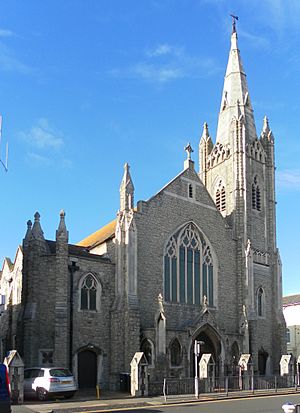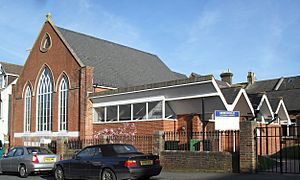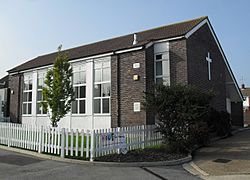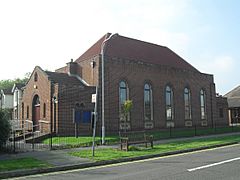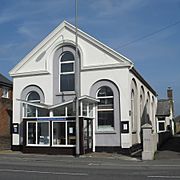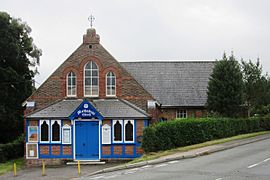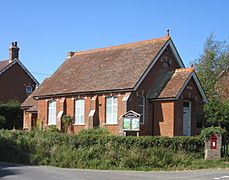Central Methodist Church, Eastbourne facts for kids
Quick facts for kids Central Methodist Church |
|
|---|---|
| Deliverance Centre Eastbourne | |

The church from the east-southeast
|
|
| 50°46′08″N 0°17′20″E / 50.7689°N 0.2888°E | |
| Location | Pevensey Road, Eastbourne, East Sussex BN21 3HJ |
| Country | England |
| Denomination | Methodist |
| History | |
| Status | Church |
| Events | 9 September 1908: registered for marriages 2018: closed as a Methodist church and reopened as a Pentecostal church January 2019: marriage registration as a Methodist church formally cancelled |
| Architecture | |
| Functional status | Active (as Pentecostal church) |
| Heritage designation | Grade II |
| Designated | 13 August 1996 |
| Architect(s) | Carlos Crisford |
| Style | Decorated Gothic Revival |
| Groundbreaking | 1 April 1907 (Sunday school); 14 April 1908 (church) |
| Completed | 16 September 1908 |
| Construction cost | £15,000 (£1,123,000 in 2021) |
| Specifications | |
| Capacity | 1,000 |
| Administration | |
| Circuit | Eastbourne (until 2018) |
The Central Methodist Church was once the main Methodist church in Eastbourne, a town in East Sussex, England. This large building in the town center, with schoolrooms, took the place of older Methodist churches. Soldiers first brought the Methodist faith here in 1803. Back then, Eastbourne was just a few small villages on cliffs, not the busy town it is today. A group they started in 1803 to help Methodism grow is still around.
Carlos Crisford, a local Methodist and historian, designed this beautiful church in 1907. It has been used for worship ever since. Even as other Methodist churches in the town have closed, this one has stayed open. For some years until 2013, a Baptist church also used the building. Central Methodist Church is a Grade II listed building, which means it's an important historic building.
In 2018, Methodist churches in Eastbourne made some changes. Central Methodist Church joined with other churches to form a new group called Emmanuel Church. They decided to use one main building for worship. Because of this, Central Methodist Church closed as a Methodist church. A Pentecostal group then took over the building. They renamed it Deliverance Centre Eastbourne and still use it as their main church today.
Contents
History of the Church
Methodism Comes to Eastbourne
In the early 1800s, Eastbourne was mostly farmland with four small villages. These were Bourne (now Old Town), Southbourne, Sea Houses, and Meads. About 1,668 people lived there in 1801. The main church for everyone was St Mary the Virgin Church.
Sea Houses became important in the late 1700s. Houses were built facing the sea around 1790. The area also became key for defending the coast against Napoleonic invaders. Soldiers arrived in Eastbourne in July 1803.
These soldiers likely started the Methodist faith in Eastbourne. A local historian, Carlos Crisford, first suggested this. Research shows there were no Methodists here before 1803. The soldiers were Dissenters, meaning they were Protestants who were not part of the Church of England. They were allowed to set up a place of worship in one of the houses at Sea Houses. In 1803, they formed the "Society of the People Called Methodists." This group aimed to spread their beliefs in Eastbourne. The house they used is no longer there. Today, 27 and 28 Marine Parade stand on that spot.
Many soldiers left Eastbourne in 1804. But their services had interested local people. With help from a shop owner named Henry Beck, the Methodist group continued to grow. Beck moved from nearby Lewes in 1804. He joined the group and became an important Methodist preacher. In 1808, Rev. Robert Pilter, a famous Methodist missionary, also helped the Eastbourne church grow.
Pilter helped the community get their first permanent church building. In September 1809, Rev. Robert Wheeler bought land in the Southbourne area for £145. The church officially opened on March 28, 1810. It cost £861 to build. As Eastbourne grew into a popular resort, more wealthy visitors came. The church had to be extended soon after it opened.
However, problems arose. The Napoleonic Wars ended in 1815, and all soldiers left Eastbourne. This meant fewer followers for the church. In 1817, Henry Beck moved away. The church also had debt from its construction. Storm damage in the 1840s meant services had to be held outside for a while. The number of church members was very low by 1860.
The Pevensey Road Chapel
Despite the difficulties, most of the debt was paid off. Church members decided to build a new church closer to the growing town center. By 1860, the seafront area was the new main part of Eastbourne.
A preacher named Thomas Scott helped the church get a permanent resident preacher. This happened in 1860. The Lewes Methodist Circuit, which was a larger church area, was renamed "Lewes and Eastbourne." Scott also gave £25 to the building fund for the new church.
The new church was built on Pevensey Road. Eastbourne's Methodists bought a plot of land in 1863. Building work started almost right away. Sir Francis Lycett, an important Methodist leader, laid the foundation stone on November 11, 1863. Architect R.K. Blessley designed the church. It was built in the Gothic Revival style, using flint and stone. The Pevensey Road Chapel opened in July 1864. It cost about £1,875. The old church on Grove Road was sold to another Baptist group.
Church numbers grew slowly. A scarlet fever outbreak in 1864 scared many visitors away. But the Methodist community was now firmly established in Eastbourne. They began to reach out more. A new Sunday school opened behind the church in 1869. Several new Methodist chapels were also started in nearby villages and new parts of Eastbourne. In 1871, a separate Eastbourne Circuit was created. This made it easier to manage the churches in the area.
Building the New Central Church
By 1896, the Pevensey Road Chapel had over 250 regular members. In summer, there wasn't enough room for all the visitors who wanted to worship. By 1902, a bigger plan was announced. They wanted to replace the chapel with a "central church" that could hold 1,000 people. This new church would be the main center for Methodists in Eastbourne. Church members formed a committee to raise money for the new building.
In 1904, the Pevensey Road Chapel was found to be unsafe. More than £3,000 was already in the building fund. Another committee was formed to oversee tearing down the old chapel and building a much larger church and schoolroom. Permission to demolish the chapel was given in 1906. On April 1, 1907, work began on the new buildings. The foundation stone for the Sunday school was laid. Arthur Henderson, a politician and Methodist, spoke at a public meeting. People were encouraged to donate to the building fund. While the old chapel was being torn down, church services were held in the former Sunday school hall.
By early 1908, the new Sunday school was finished. Work then began on the church itself. The foundation stone was laid on April 14, 1908. Construction took five months and cost about £15,000. Some of the money had been used to start new Methodist churches in other parts of Eastbourne. Rev. John Scott Lidgett, a leader of the Methodist Conference, opened the new Central Methodist Church on September 16, 1908. Carlos Crisford designed it, and a local company built it. The building had a tall corner tower with a spire. To celebrate the opening, a group of people were lifted in a box to the top of the spire, where they ate breakfast!
The number of members at Central Methodist Church grew from about 200 when it opened to 254 in 1917. Money was slowly raised to pay off the debt. The last payments were made in 1925. Many fundraising activities helped, along with help from J. Arthur Rank, a Methodist businessman. Between the two World Wars, new clubs and groups were formed. Funds were also set up to help people during the Great Depression. A war memorial was put in to remember 18 church members who died in World War I. In 1934, a Methodist guest house opened nearby. Many guests would worship at the church during their stay.
Central Methodist Church helped during World War II. Its large size and central location made it a "reception center." Thousands of people evacuated from London passed through on their way to temporary homes. By 1940, Eastbourne was at high risk of attack. So, thousands of residents were sent to the church before being evacuated out of town. The church was a "controlled zone" for Eastbourne. About 35,000 people passed through in just a few days in September 1940.
Many churches in Eastbourne were damaged by bombs during the war. But Central Methodist Church survived. Once, an unexploded bomb landed nearby, but it didn't go off. The church building was temporarily closed because it was in a risky area. But services continued in the crypt, which also served as a shelter. The Sunday school also closed for a time.
Church membership continued to rise after the war. Eastbourne recovered and grew again. The highest number of members was 486 in 1967. By then, youth clubs, women's groups, and a choir had been started. The "Society of the People Called Methodists," founded in 1803, continued its history by meeting regularly at the church.
Central Methodist Church was named a Grade II Listed building on August 13, 1996. This means it's a very important historic building. It was also registered for marriages on September 9, 1908.
Recent History and Changes
For several years until 2013, a Baptist church shared the building. This was the Ceylon Place Baptist Church. Their own building had closed and was turned into apartments. The Baptist group, now called New Hope Baptist Church, later moved to a new building.
In 2015, the Methodist and United Reformed Churches planned to combine four of their churches in Eastbourne. They decided to build a new church called Emmanuel Church. This meant Central Methodist Church and two others would close. Central Methodist Church's Methodist members left the building in 2018. It is now used by the Church of God Worldwide Mission. This Pentecostal group had been meeting locally since 1998. They had shared Central Methodist Church since 2009. They now hold regular services and prayer meetings there. The church is now known as Deliverance Centre Eastbourne. Its old registrations for worship and marriages were canceled in January 2019.
Church Design
Central Methodist Church is a detailed Gothic Revival building. It is made of grey stone with some smooth, cut stone. The roof has tiles, but these are not the original ones. One expert said it looks "entirely churchy," meaning it looks more like a traditional church than other Nonconformist chapels of its time.
The church and its other buildings are on a corner. The church entrance is on Pevensey Road. Its side faces Susans Road. Next to it on Susans Road are the Sunday school and church hall. The church entrance is in a porch next to the tower. The porch has two pairs of tall, narrow windows. Above these is a wide window with seven lights and decorative stone patterns. The double doors in the porch have a carving of a Bible verse: "enter into his gates with thanksgiving and into his courts with praise." The Susans Road side has five sections, each with a pointed roof and arched windows. There is another porch at the other corner.
The tower has three levels. The top level has a bell area with vents and windows. Above this, the stone spire has small dormer windows and a weather-vane.
The inside of the church still looks original. A wooden balcony runs around the church. It is supported by thin iron columns. Other original features include the pews (church benches), a pulpit (where the preacher stands), and a case for a large pipe organ.
The church hall is a two-story stone building. It has pointed roofs, ironwork, and tall, narrow windows. The Sunday school next to it also has two stories. It looks like a Jacobean building, with small castle-like towers in several places. Inside, there is a staircase with fancy ironwork.
Other Churches Connected
Central Methodist Church was the main church in the Eastbourne Methodist Circuit. This is a group of Methodist churches in the area. It was connected to several other Methodist churches in Eastbourne and nearby villages.
Greenfield Methodist Church is a red-brick building. It has served Eastbourne's Old Town area since 1898. The Pevensey Road Chapel, the church before Central Methodist, helped start and pay for this new church.
In Eastbourne's East End, chapels were started in 1886 and 1904. Another church, St Aidan's, opened nearby in 1913. These churches later joined together. St Aidan's Church closed and was torn down in 2001.
The Hampden Park housing area got its first church in 1960. Central Church played a big part in starting this community. St Stephen's Church (now Broadway United Church) opened on July 23, 1960. It was made bigger 11 years later. Central Church also helped open a new united church in the growing area of Langney. St Barnabas United Church opened in 1976.
Willingdon, a nearby village, joined the Circuit in 1894. A red-brick church was built there for over £400. Trinity Church there is now shared with United Reformed and Baptist worshippers.
Churches in the towns of Hailsham, Cross-in-Hand, and Gamelands (near Horam) are also part of the Circuit. The minister of Central Methodist Church was also in charge of Blacknest Chapel. This small brick chapel opened in 1891. It closed and was torn down in the early 2000s.
- Associated churches
See also
- List of places of worship in Eastbourne
- Listed buildings in Eastbourne




